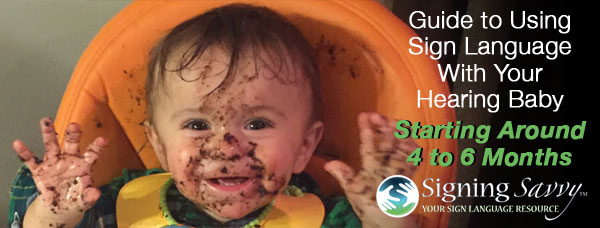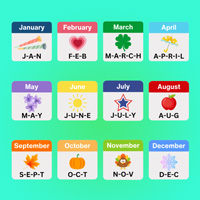
Guide to Using Sign Language With Your Hearing Baby: Signing With Food - Starting at 4 to 6 Months (whenever they start eating)
It’s easy to start signing with your baby and it’s amazing to be able to communicate with them through sign before they are able to talk. To get started, simply use signs when communicating with your child. There isn’t a “right” way or specific order to learning or teaching signs, just start by picking signs that make the most sense in the context of your baby’s life. There is no limit to how many signs you should introduce at a time, so sign as much as you are comfortable with. In particular, fluent signers and parents with deaf children should sign as much as possible.
This is just one example of how you could introduce signs to a baby that is 4 to 6 months old and comes from the prospective of hearing parents with hearing children.
What’s for dinner?
Doctors recommend first introducing food to babies around the age of 4 to 6 months (check with your doctor to see what they recommend for your baby). Because of this, it is a great time to introduce food signs. You can simply introduce the sign for each new food as they try it. Remember that repetition is important in learning language, so sign the food each time you give it to your child.
In addition to specific food signs, you may also want to use EAT (Let’s EAT; Do you want to EAT?), DRINK (Take a DRINK; Do you want a DRINK?), HUNGRY, and THIRSTY (Are you HUNGRY/THIRSTY? I am HUNGRY/THIRSTY.). The sign for EAT is a common sign that can also be used to mean food, meal, snack, and dine.
Some basic signs for describing food at this age/stage are HOT, COLD, MORE (“Do you want MORE?”) and ALL DONE (“Are you ALL DONE?”).

Signing Savvy Member Feature: Download this image / flyer as a printable PDF page.
Don’t play with your food? Describing food, including the color.
As soon as your child is born, they are developing their senses. Even introducing food to your little one is a great sensory activity. Children love to look, taste, and feel the world around them, including food. It’s actually great for them to play with their food; they learn a lot through play! As they try new foods, encourage them to check it out, pick it up, and feel it in the process of tasting it.
Ask them if they like how the food tastes, how it feels and describe it to them – what texture is it, what temperature is it, what color is it? Remember that although your child can’t answer your questions, they are learning through play and from your actions, how you describe the food items, and what you sign. This is a great opportunity to introduce color signs (and other descriptive signs) as you talk about the food you give your child.

Signing Savvy Member Feature: Download this image / flyer as a printable PDF page.
Reading Time
In addition to signing food and color signs while you are eating, you can sign while reading books that talk about food, like The Very Hungry Caterpillar, where you learn about all the things the very hungry caterpillar ate throughout the week. Reading books that incorporate the same vocabulary/signs that you use throughout the day will increase exposure, reinforce the use of them, and help your little one learn them.
More Resources to Help You Get Started
Signing Savvy Wordlists:
Printable Posters
Book: The Very Hungry Caterpillar








 Use Sign Language to Communicate With Your Hearing Baby Before They Can Talk – An Overview of Why to Use American Sign Language (ASL)
Use Sign Language to Communicate With Your Hearing Baby Before They Can Talk – An Overview of Why to Use American Sign Language (ASL) When and How to Start Using Sign Language With Your Hearing Baby
When and How to Start Using Sign Language With Your Hearing Baby Guide to Using Sign Language With Your Hearing Baby: 0 to 6 Months
Guide to Using Sign Language With Your Hearing Baby: 0 to 6 Months The Importance of Early Exposure to American Sign Language with Deaf Children
The Importance of Early Exposure to American Sign Language with Deaf Children







